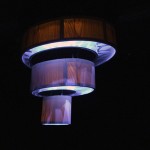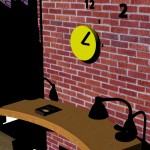by Meerthe Heuvelings. [PDF, 2.3M]

“In the ‘Contextual Information Exchange’ project, the focus was on communicating the context of one user to another user. In this project I focused on creating a feeling of connectedness over distance. To create this feeling of connectedness, I did research to the missing-links between face-to-face and distant communication and concluded that virtual shadows of real physical objects or people can create a feeling of physical presence on ‘the other side’.
In this project we worked in three iterations, the last two iterations were done individually. In the second iteration I developed a concept in which the shadows of stones can form a new medium of communication over distance. The stones on one side are transfered into shadows on the other side and vice versa. This will create a decorative piece of stones and shadows, that is made with use of two persons that live on a distance from each other.
The final concept is the ‘Movow’, which stands for ‘Moving Shadow’. In this concept the amount of people and the speed with which these people move are detected in one room, and transfered into shadows of the ‘Movow’ light object in another room. The ‘Movow’ is able to generate shadows according to the amount of people and movement. When there are not that much people in the other room, only the lower ring of the prototype will be lit. When the amount of people increases, the light will ‘grow’ to the ceiling. The speed with which the lights will be circulate in the rings, depends on the movement of the people in the other room. For this concept a prototype is build that represents the light and shadow capabilities of the concept.”
